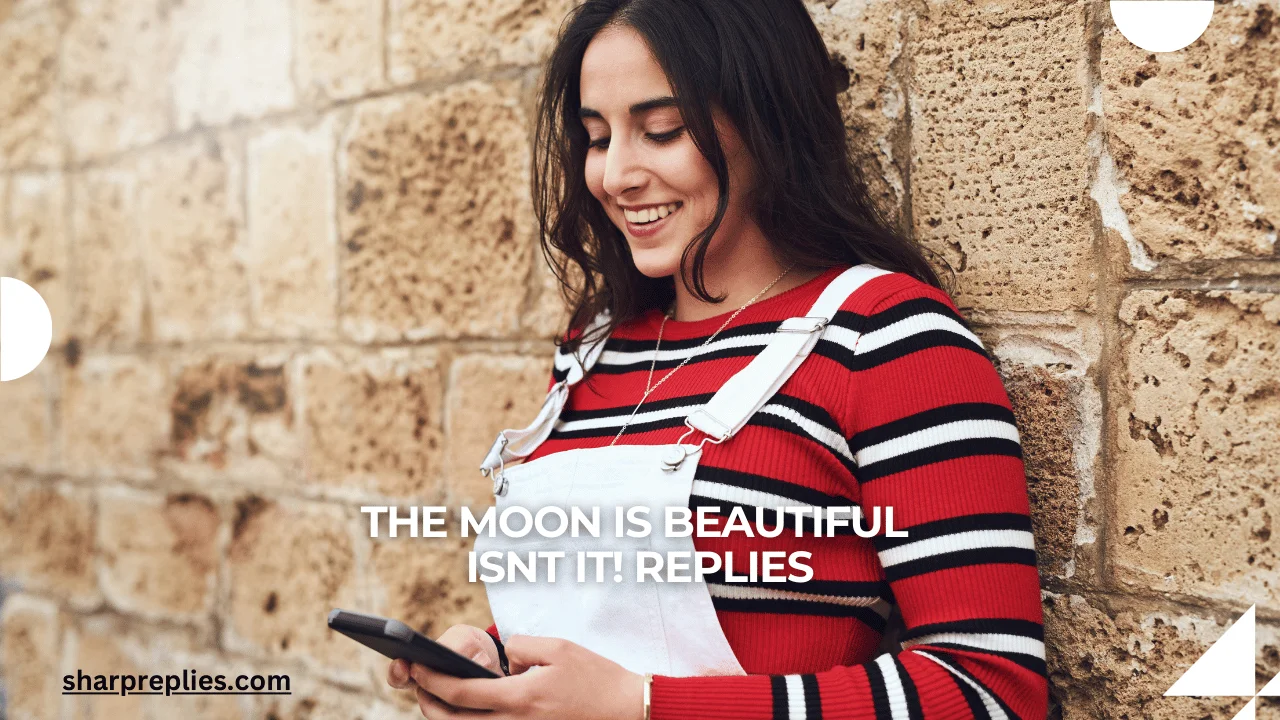“The moon is beautiful, isn’t it?” This phrase, often attributed to Japanese literature, carries a deep cultural significance that resonates far beyond its surface simplicity.
While the moon may seem like a common feature in our nightly sky, the way people respond to its beauty has profound emotional and cultural implications. The significance of such a statement and its replies have fascinated philosophers, poets, and everyday people alike.
In this article, we delve into the deeper meaning behind this poetic phrase and explore how different cultures perceive and react to the moon. Through this exploration, we’ll also examine how these replies reflect our understanding of beauty, nature, and human connection.
Contents
- 1 The Origin of the Phrase: “The Moon is Beautiful, Isn’t It?”
- 2 Why Do People Respond the Way They Do to the Moon’s Beauty?
- 3 Cultural Interpretations of the Moon and Responses to Its Beauty
- 4 The Psychological and Emotional Connection to the Moon
- 5 The Moon as a Metaphor for Human Connection and Love
- 6 Conclusion
- 7 FAQ’s
- 7.0.1 Why is “The moon is beautiful, isn’t it?” such a significant phrase in Japanese culture?
- 7.0.2 What other cultures have unique responses to the moon’s beauty?
- 7.0.3 Can the moon’s beauty influence a person’s emotions?
- 7.0.4 What does a reply like “Just like us” mean when someone talks about the moon?
- 7.0.5 Is the moon always seen as beautiful in every culture?
- 7.0.6 What are some common poetic replies to “The moon is beautiful, isn’t it?”
The Origin of the Phrase: “The Moon is Beautiful, Isn’t It?”
The phrase “The moon is beautiful, isn’t it?” is often connected to Japanese literature, specifically to a translation of a phrase by Natsume Sōseki, one of Japan’s most celebrated authors.
In his novel I Am a Cat, Sōseki writes that when his character’s love interest says, “The moon is beautiful, isn’t it?” she is expressing a kind of poetic sentiment toward the moon. In the Japanese context, however, this phrase was never just about admiring a celestial body—it was used as a subtle way of expressing love or affection.
Instead of directly saying “I love you,” the moon, with its serene, distant glow, was the perfect metaphor for emotions too deep to express directly. This phrase, like the moon itself, transcends mere words, suggesting that beauty often lies in subtlety and indirectness.
Why Do People Respond the Way They Do to the Moon’s Beauty?
When someone says, “The moon is beautiful, isn’t it?”, the typical response often carries a sense of appreciation, awe, or simply an acknowledgment of the shared beauty in nature. But why do such simple observations strike a chord with us?
The moon has been a symbol of mystery and romance for millennia across various cultures. Its quiet presence in the sky offers a chance for contemplation and reflection. In many cultures, the moon represents emotional balance, reflection, and transcendence.
As a result, the act of responding to a statement about the moon is often an intimate and emotional exchange that reflects how deeply human beings connect to nature’s beauty.
Some may respond with a philosophical remark, others with a more poetic response, and some might simply say, “Yes, it is.” The variety of responses stems from individual perspectives and cultural backgrounds, all of which shape the way we interpret beauty and the world around us.
Each reply can serve as a unique insight into the person’s worldview, emotional state, or even their way of connecting with others.
Cultural Interpretations of the Moon and Responses to Its Beauty
The moon’s beauty isn’t universally appreciated in the same way across all cultures. While the Japanese might use the moon as a metaphor for love or deep emotions, other cultures have different associations with it.
For example, in Western culture, the moon has been seen as a symbol of mystery, dreams, and sometimes madness (e.g., the term “lunatic” comes from the Latin word for moon). In many ancient civilizations, the moon was revered as a powerful deity, associated with fertility, wisdom, or protection.
Responses to the moon’s beauty also vary across cultural lines. In the West, people may respond more casually, acknowledging the moon’s loveliness in a literal sense.
In contrast, other cultures, such as those in the Middle East or China, may incorporate poetic responses reflecting spiritual or philosophical beliefs. Understanding these diverse responses provides deeper insights into the way cultures perceive beauty and the forces of nature.
The Psychological and Emotional Connection to the Moon
The moon has a unique psychological effect on people. Its light, though dimmer than the sun, carries a calming or even eerie presence, depending on the time of night.
In psychological studies, the moon is sometimes linked to changes in mood or behavior—why else would it be so often associated with mysticism and emotional extremes? For some, gazing at the moon provides a moment of quiet reflection.
Others might find themselves stirred by a sense of nostalgia or longing, as the moon has been a constant witness to human history.
When someone replies to the phrase “The moon is beautiful, isn’t it?” with a simple acknowledgment or a philosophical musing, it can indicate their emotional state at that moment.
They might be feeling peaceful, reflective, or romantic, all of which are emotions commonly connected to the moon. The exchange becomes not just about the celestial body itself, but about shared emotions and the human connection to the night sky.
The Moon as a Metaphor for Human Connection and Love

One of the most poignant interpretations of the moon’s beauty lies in its use as a metaphor for human relationships.
Just as the moon changes phases, from new moon to full moon and back again, human relationships go through cycles of growth, closeness, and distance.
The moon, with its ever-present light, offers a symbol of enduring love, suggesting that even when people are apart, they are still connected in some way, much like the moon’s continuous presence in the night sky.
When someone responds to “The moon is beautiful, isn’t it?” with, “Yes, just like us,” they are likely expressing a deep emotional connection, drawing a parallel between the celestial beauty and the beauty of their relationship.
This poetic reply highlights the universality of love and connection that transcends both time and space, much like the moon itself.
Conclusion
In conclusion, the simple phrase, “The moon is beautiful, isn’t it?” and its replies open the door to a world of emotional resonance, cultural significance, and human connection. While the moon’s beauty can be appreciated by anyone, how we respond to it is shaped by our individual perspectives, cultural backgrounds, and emotional states.
Whether it’s used to express love, wonder, or nostalgia, the act of acknowledging the moon’s beauty speaks to something deep within all of us: a shared appreciation for the mysteries of the world around us.
So, the next time you find yourself gazing at the moon, take a moment to reflect on what it means to you—and maybe, just maybe, you’ll have the perfect reply to share with someone special.
FAQ’s
Why is “The moon is beautiful, isn’t it?” such a significant phrase in Japanese culture?
In Japanese culture, the phrase is often used as a poetic way to express love or deep affection, without directly saying “I love you.” It’s subtle and emotionally rich, connecting nature’s beauty to personal feelings.
What other cultures have unique responses to the moon’s beauty?
Cultures such as those in ancient Greece, China, and the Middle East have rich mythologies surrounding the moon, often linking it to gods, fertility, and emotional well-being. Responses vary, but they generally involve deep spiritual or philosophical reflection.
Can the moon’s beauty influence a person’s emotions?
Yes, many people feel a sense of calm, awe, or nostalgia when they look at the moon. Psychological studies have shown that the moon’s presence can trigger emotional or reflective states, making it a powerful symbol.
What does a reply like “Just like us” mean when someone talks about the moon?
This response is often a metaphorical expression of love or connection, implying that just as the moon’s beauty is constant, so too is the bond between the people involved.
Is the moon always seen as beautiful in every culture?
While the moon is generally admired, different cultures have diverse views. In some, the moon symbolizes mystery, madness, or even bad omens, while in others, it represents hope, love, and peace.
What are some common poetic replies to “The moon is beautiful, isn’t it?”
Some common replies include expressions of romantic love or admiration, such as “Yes, just like you,” or “It’s a beauty shared by us all.”








